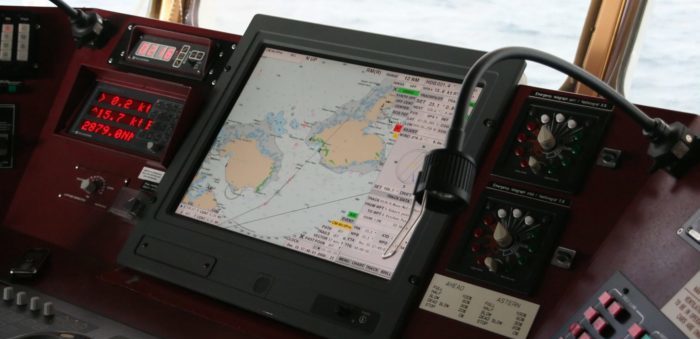Swedish Club’s Navigational Claims 2020 issue focuses on collision incidents, this time presenting a collision caused after a vessel’s grounding, believed to have been caused because the master did not follow the passage plan as is.
The Incident
In evening hours, vessel A, a 2,470 TEU container vessel, was approaching port, an hour earlier than what the master had previously planned, as the orders were that the vessel should have arrived at 20.40. Thus, to make the new ETA, the crew had to increase the vessel’s speed from 10 knots to 14.
The Master did not go in line with the passage plan, but decided to follow a shortcut through an anchorage. During this change, the third officer was on the bridge along with the OOW, the Navigation Officer, the Master who had the conn and the Chief Officer who was monitoring the traffic both on radar and visually, and in the meantime talking through the VHF radio.
At the same time, an AB was manually steering, and the third officer was filling out the logbook. The two ARPA radars were in north up, relative motion and the radars were switched between 3 NM and 6 NM range. The CPA alarm was set to 0.3 NM.
Moreover, the second officer, also being the navigation officer, had already entered the waypoints for the original plan into both ARPA radars and the ECDIS, and a cross-track error alarm of 1 cable had been set up.
During the approach he was not on the bridge and the passage plan was not updated for the shortcut as the Master did not consider it was necessary to update the passage plan.
C-15 minutes: During the approach to the pilot station there were two smaller vessels ahead of vessel A that would be overtaken on their starboard side. Shortly after the vessels had been overtaken the Master ordered an alteration to port which meant that vessel A crossed in front of the bow of the two vessels.
C-12 minutes: The Master was also aware of two outbound vessels from the port, vessels B and C. These vessels were not acquired on the radar. Vessel B called up vessel A and asked what their intentions were. The Master responded that he would like to have a port-to-port passing. Vessel B replied that it was turning hard to starboard to make the passing. The Master altered course to starboard. At this time vessel B was about 1 NM away on the port bow.
C-9 minutes: The Master became aware of vessel C on the port bow. He could see the green, red and forward top lights on vessel C but did not take any action. Vessel A was maintaining a speed of 10 knots.
C-7 minutes: The Master decided to open up/increase the CPA by altering 5 degrees to starboard for vessel C. A minute later the Master realised that vessel C was very close, and he ordered full ahead and hard to starboard. The vessels just passed each other clear by 10 metres. When vessel C was abeam the Master became aware of an island just ahead and he ordered hard to port. When C passed clear the Master ordered midships and then 20 degrees to port.
C-4 minutes: A minute later the pilot called the vessel on the VHF and asked why the vessel was heading dangerously close to the island. The vessel was now very close to it. The Master once again ordered midships and believed they would stay clear of the island.
C-3 minutes: Suddenly the vessel started to vibrate heavily and there was a loud noise. The vessel’s speed was reduced to 5 knots. The Master was initially confused about what had happened but then understood that the vessel had hit the bottom but was still making way.
C-2 minutes: The Master identified that vessel D was at anchor only 0.15 NM ahead of them, at which point the AB informed him that the rudder was not responding. The Master ordered starboard 20 and then hard to starboard, but the AB repeated that the rudder was not responding. The vessel was now sailing at about 7 knots. The Chief Officer suggested dropping the anchor but the Master declined.
Collision:
The Master ordered full astern but shortly afterwards vessel A’s bow hit the side of vessel D.
It is reported that the master reported the vessel’s grounding to the VTS but did not consider it was important to also report the collision. A bit later, the vessel managed to disengage from vessel D by engine manoeuvres and later dropped anchor.
COLREGs
a) Rule 5 – Look out: Every vessel shall at all times maintain a proper look-out by sight and hearing, as well as by all available means appropriate in the prevailing circumstances and conditions, so as to make a full appraisal of the situation and of the risk of collision.
The bridge was manned properly in terms of number of individuals present and number of functions represented. However, the different members of the bridge team had not been assigned properly defined roles and duties. The Master was in charge but he did not use the members of the bridge team to provide him with the information he needed to make decisions about the safe navigation of the vessel. A bridge team will be more efficient if roles and responsibilities are defined as outlined in The Swedish Club Bridge Instructions booklet (see Appendix (i)).
b) Rule 6 – Safe speed: Every vessel shall at all times proceed at a safe speed so that she can take proper and effective action to avoid collision and be stopped within a distance appropriate to the prevailing circumstances and conditions. In determining a safe speed, the following factors shall be among those taken into account: (a) By all vessels: (ii) the traffic density including concentrations of fishing vessels or any other vessels: (iv) at night the presence of background light such as from shore lights or from back scatter of her own lights
Proceeding at a speed of 14 knots through a busy anchorage can probably be considered to be unsafe. We know that the Master stated at the hearing following the incident that the vessel was not proceeding at a safe speed but that he was determined to make the ETA.
[smlsubform prepend=”GET THE SAFETY4SEA IN YOUR INBOX!” showname=false emailtxt=”” emailholder=”Enter your email address” showsubmit=true submittxt=”Submit” jsthanks=false thankyou=”Thank you for subscribing to our mailing list”]
c) Rule 7 – Risk of collision: (a) Every vessel shall use all available means appropriate to the prevailing circumstances and conditions to determine if risk of collision exists. If there is any doubt (then) such risk shall be deemed to exist. (b) Proper use shall be made of radar equipment if fitted and operational, including long-range scanning to obtain early warning of risk of collision and radar plotting or equivalent systematic observation of detected object
All available equipment on the bridge should be used to determine if a risk of collision exists. In this case not all the vessels were plotted on the ARPA, not even vessels which were in close quarter situations. It is imperative to plot all vessels to determine if risk of collision exists. The bridge was manned with three officers including the Master. However, the Master had not delegated the task of monitoring surrounding traffic and report close quarters situations before they became dangerous.
d) Rule 8 – Action to avoid collision: (a) Any action to avoid collision shall be taken in accordance with the Rules of this Part and shall, if the circumstances of the case admit, be positive, made in ample time and with due regard to the observance of good seamanship. (b) Any alteration of course and/or speed to avoid collision shall, if the circumstances of the case admit, be large enough to be readily apparent to another vessel observing visually or by radar: a succession of small alterations of course and/or speed should be avoided.
The Master appears not to have communicated his intentions to the bridge team. The Master did not make a proper appraisal of the possibility of arriving at the pilot station at the time requested by the pilots.
Lessons Learned:
- Causes of the vessels grounding and collision include a change to the passage plan; the order to arrive earlier at the pilot station. This is a common root cause of groundings and other accidents.
- In his desire to arrive at the pilot station on time the Master lost focus on safe navigation. He improvised the passage plan, which meant that no evaluation of the safety of the route was made. He demonstrated a complete loss of situational awareness. He failed to communicate his intentions to the bridge team and did not delegate tasks to the officers on the bridge. A proper evaluation of the options would probably have resulted in the Master calling the pilots to say that they could not make the desired ETA but would arrive 20 minutes later.
- It is not good seamanship to cross in front of vessels that have just been overtaken. Once again it highlights the risks the Master was willing to take risks to make the ETA.
- Any deviation from the passage plan other than for collision avoidance should be documented and subject to a proper appraisal. The passage plan should be berth to berth and not only pilot station to pilot station. The new passage plan needs to be entered in the ECDIS. All bridge team members need to sign the updated passage plan. If paper charts are used, the charts must be updated and the route plotted on the charts.




























































